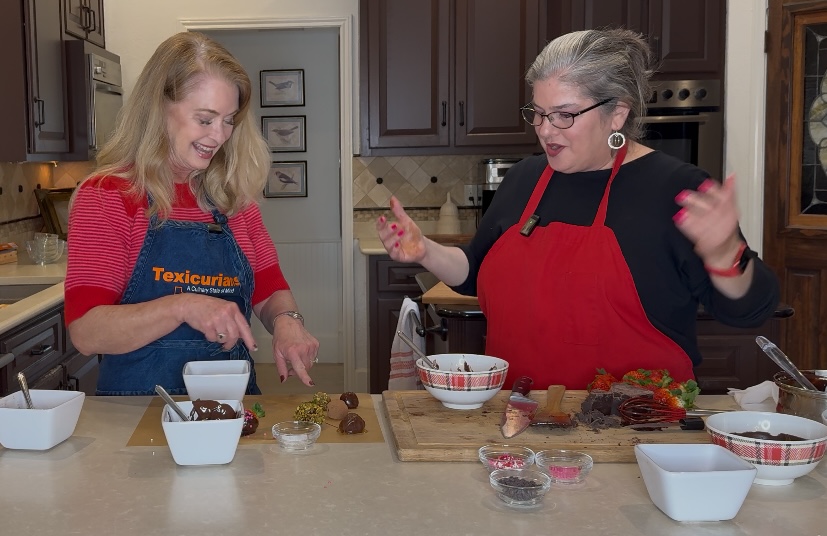Grab your friends for an evening of shopping spring fashions and being inspired!
Tables of 8 for $100. See QR code below:

Grab your friends for an evening of shopping spring fashions and being inspired!
Tables of 8 for $100. See QR code below:

Chocolate Truffles and Texas Justice
Who would have thought that a Texas District Judge would be a hobby Confectioner? Well let me introduce you to The Honorable Judge Stephanie Bascon!
Judge Bascon worked for a candy confectioner in college and has honed her skills through the years as an avocation. We hopped into the kitchen where she shared her knowledge of chocolate and the truffle process. She even showcased for us an 11 pound block of Callebaut Belgian chocolate that was a staple for her mentor!
Valentines just calls for chocolate! And this month we’re going to show you that creating your own – in the form of truffles, can be super easy with dramatic results.
But first – as your mom would say, “Eat your dinner and then dessert!” So, here’s a little history on the Texas Judicial System. (Then we’ll get to those truffles!)
Texas has a unique Judicial system history. Its formation was Influenced by Spanish, Mexican, Republic of Texas and United States governance.
Here’s a quick historical summary: From 1716 – 1821 the Spanish system was closely tied to the Catholic Church and royal authority. The Mexican rule era (1821-1836) when Texas was part of the Mexican state of Coahuila y Tejas, used municipal councils for local disputes, but all higher courts were referred to Saltillo.
During the time of the Republic of Texas (1836-1845) the judicial system closely resembled and was modeled after that of the United States. Due to lack of funds, however, frontier law enforcement was difficult. After joining the Union, the US common law was adopted but also included some Texan traditions.
District Judge Gary Steel has a love of Texas’ unique Judicial history and was kind enough to share his insight with us:
“We have two supreme courts in Texas – the Texas Supreme Court for civil matters and the Texas Court of Criminal Appeals for criminal matters. Both are the highest courts in the State and have no overlapping jurisdiction. Almost all states, including the Federal System, combine ultimate, or courts of last resort, into one court which has jurisdiction over all matters – civil and criminal.
We are in the minority of states because we elect all our judges, as opposed to the appointment system used by the other states. We are even in a greater minority because our elections are by political party.
The judicial system is made up of several different levels: Appellate courts, which include the Texas Supreme Court and the Court of Criminal Appeals, as well as several intermediate appellate courts and District Courts which are the highest trial courts in the state. All of the above were formed by the Texas Constitution.
Next there are County Court at Laws, which are statutory courts. Their jurisdiction varies according to the powers given to them in their specific legislation.
Then there are justices of the peace and county judges. County judges have limited judicial powers. These are also in the Texas Constitution and among other limited jurisdiction trial courts for smaller misdemeanor and civil matters.
Finally there are many magistrates who are appointed by varying elected judges whose decisions are almost always appealable to an elective judicial officer.
Judge Steel adds, “From a Texas historical perspective, I find it interesting that when Stephen F. Austin went to the government of Mexico in 1834 to file his grievances, one of his major objections was that Mexican judicial law did not include a jury system. Austin was arrested on this trip and held in Mexican prison for a year and a half. Since Texas Independence, the right to a jury trial has been a pillar to the Texas Judicial System.”
Thank you Judge Stephanie Bascon and Judge Gary Steel for your service.
Now for some dessert!


